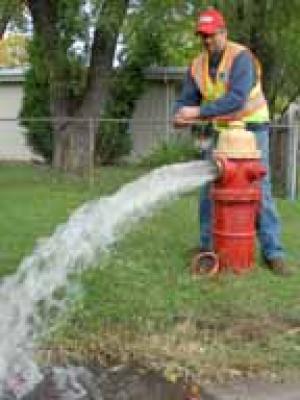-
About Homer
-
- Americans with Disabilities Act Compliance Program City Campgrounds Community Recreation Hickerson Memorial Cemetery
- Library Parks & Trails Public Safety Fire Police Emergency Information
- Events & Activities City Calendar Library Calendar Recreation Calendar Doing Business in Homer Sister City Program Coast Guard City
-
- Departments
- Government
- How Do I?
It Seems At First Glance To Be Such A Waste!
Periodically, you will see Public Works personnel releasing water from fire hydrants. Homer residents often ask why the City flushes water from fire hydrants. It seems at first glance to be such a waste. The answer is that regular hydrant flushing is a vital part of routine water system maintenance for these important reasons:
• Improves water quality: Flushing removes minerals such as iron and magnesium that have collected in the water mains.
• Hydrant maintenance: A fire hydrant is a mechanical device. Operation of a hydrant lubricates internal mechanisms and gaskets.
• Hydrant inspection: Any deficiencies are noted and repaired as necessary to insure that each hydrant will perform when needed in an emergency.
In Homer there is another important reason for flushing water mains. The City is required to maintain trace residual chorine in the water to assure that it is protected from contamination by pathogens once it leaves the treatment plant. Over time, chlorine breaks down; water without chlorine residual can no longer be considered microbiologically clean. The water distribution system in Homer consists of approximately 50 miles of water main with only 1400 customers. Because of the low number of customers per mile of water main, water can be stored within the system longer than the chlorine residual lasts. By flushing or bleeding water out of the system; especially off “dead-end lines” (like the 5 mile long Homer Spit dead-end water line); safe, pathogen-free drinking water is maintained through the distribution system.
If that isn’t enough to justify flushing water off hydrants, chlorine in contact with organics in the treated water produces “disinfection byproducts”. The longer the contact time, the more byproducts are produced. Some studies have shown that these byproducts, at high enough levels can pose health risks. By flushing or bleeding water off the distribution system (especially long dead-end lines), the levels of these byproducts can be kept below levels considered unsafe. It is important to provide protection from pathogens (maintaining a chlorine residual), while simultaneously minimizing health risks from disinfection byproducts (by minimizing detention times).



